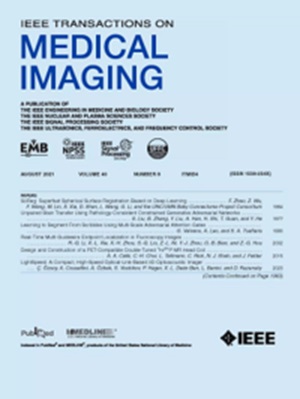同时多VENC和同时多切片相位对比磁共振成像
IF 8.9
1区 医学
Q1 COMPUTER SCIENCE, INTERDISCIPLINARY APPLICATIONS
引用次数: 0
摘要
这项工作开发了一种新的、同时进行多VENC和同时进行多切片(SMV+SMS)成像的单次采集,用于稳健相位对比(PC)MRI。为此,脉冲序列被设计为允许在共享频率编码梯度上同时采集多个VENC以及多个切片,其中通过调整净梯度面积来控制多个VENCs的每个有效回波时间,同时通过使用多频带共振频率(RF)脉冲来同时激励多个切片。对于VENC和切片分离,分别应用RF相位循环和梯度光点来产生沿相位编码方向的VENC间和切片间偏移。通过产生具有低和高信号幅度的振荡稳态的交替RF相位循环,通过产生沿VENC方向的虚拟维度来减少调制引起的伪影,将所获取的多VENC k空间重新表述为3D欠采样k空间。与传统的PC MRI相比,进行了体内研究以验证所提出的方法的可行性。在没有明显伪影的情况下,所提出的方法在描绘跨心时相的低流速和高流速方面显示出与传统方法相当的性能。在存在高于VENC值的高流速的情况下,与传统方法相比,所提出的方法表现出对流量信号的清晰描述,从而产生具有改进的速度动态范围的高VNR图像。本文章由计算机程序翻译,如有差异,请以英文原文为准。
Simultaneous Multi-VENC and Simultaneous Multi-Slice Phase Contrast Magnetic Resonance Imaging
This work develops a novel, simultaneous multi-VENC and simultaneous multi-slice (SMV+SMS) imaging in a single acquisition for robust phase contrast (PC) MRI. To this end, the pulse sequence was designed to permit concurrent acquisition of multiple VENCs as well as multiple slices on a shared frequency encoding gradient, in which each effective echo time for multiple VENCs was controlled by adjusting net gradient area while multiple slices were simultaneously excited by employing multiband resonance frequency (RF) pulses. For VENC and slice separation, RF phase cycling and gradient blip were applied to create both inter-VENC and inter-slice shifts along phase encoding direction, respectively. With an alternating RF phase cycling that generates oscillating steady-state with low and high signal amplitude, the acquired multi-VENC k-space was reformulated into 3D undersampled k-space by generating a virtual dimension along VENC direction for modulation induced artifact reduction. In vivo studies were conducted to validate the feasibility of the proposed method in comparison with conventional PC MRI. The proposed method shows comparable performance to the conventional method in delineating both low and high flow velocities across cardiac phases with high spatial coverage without apparent artifacts. In the presence of high flow velocity that is above the VENC value, the proposed method exhibits clear depiction of flow signals over conventional method, thereby leading to high VNR image with improved velocity dynamic range.
求助全文
通过发布文献求助,成功后即可免费获取论文全文。
去求助
来源期刊

IEEE Transactions on Medical Imaging
医学-成像科学与照相技术
CiteScore
21.80
自引率
5.70%
发文量
637
审稿时长
5.6 months
期刊介绍:
The IEEE Transactions on Medical Imaging (T-MI) is a journal that welcomes the submission of manuscripts focusing on various aspects of medical imaging. The journal encourages the exploration of body structure, morphology, and function through different imaging techniques, including ultrasound, X-rays, magnetic resonance, radionuclides, microwaves, and optical methods. It also promotes contributions related to cell and molecular imaging, as well as all forms of microscopy.
T-MI publishes original research papers that cover a wide range of topics, including but not limited to novel acquisition techniques, medical image processing and analysis, visualization and performance, pattern recognition, machine learning, and other related methods. The journal particularly encourages highly technical studies that offer new perspectives. By emphasizing the unification of medicine, biology, and imaging, T-MI seeks to bridge the gap between instrumentation, hardware, software, mathematics, physics, biology, and medicine by introducing new analysis methods.
While the journal welcomes strong application papers that describe novel methods, it directs papers that focus solely on important applications using medically adopted or well-established methods without significant innovation in methodology to other journals. T-MI is indexed in Pubmed® and Medline®, which are products of the United States National Library of Medicine.
 求助内容:
求助内容: 应助结果提醒方式:
应助结果提醒方式:


